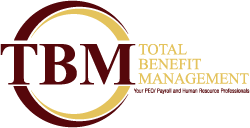- Total Benefit Management

6 Ways Managers Get into FMLA Trouble
June 27, 2018
4 Mistakes Companies Make When Promoting New Managers
July 3, 2018This article that TBM Payroll wanted to share with you comes from Society for Human Resource Management.
How to Revamp Your Harassment Prevention Program
Workplace sexual harassment has been a serious issue since long before the recent national dialogue—but the spotlight on the issue has caused many organizations to take a fresh look at their anti-harassment training, policies and practices.
“This is a problem and remains a problem in many workplaces across the country,” said Equal Employment Opportunity Commission (EEOC) Acting Chair Victoria Lipnic.
“It is a persistent issue and a pervasive one. It crosses industries. It crosses income levels. It crosses occupations,” she told attendees on March 13 at the 2018 Society for Human Resource Management Employment Law & Legislative Conference in Washington, D.C.
When considering best practices for anti-harassment measures, the focus should be on prevention. “Waiting around until something rises to legally actionable is going to be a problem for your organization,” Lipnic said.
In June 2016, Lipnic and EEOC Commissioner Chai Feldblum released a report from the EEOC Select Task Force on the Study of Harassment in the Workplace. Taskforce members included management attorneys, plaintiffs’ attorneys, professors and others.
Jonathan A. Segal, an attorney with Duane Morris in Philadelphia and New York City, spoke to conference attendees about his experience as a taskforce member. Even though there were people with different perspectives on the taskforce, everyone recognized that workplace harassment is a real problem and that no industry and no employer is immune, he said.
Almost a third of about 90,000 charges received by EEOC in fiscal year 2015 included an allegation of workplace harassment—that includes harassment based on age, disability, race, religion and other protected characteristics in addition to sex and gender.
It’s important to note, however, that many people don’t speak up about their experiences. It is pretty well confirmed that 75 percent of people who experience harassment in the workplace don’t report it, Lipnic said. They may fear retaliation or damage to their career, or they may think no one will believe them, she added.
That’s a problem for HR professionals because poor behavior needs to be addressed—but HR needs to know about it to address it. Here are some strategies for creating an environment where workers feel comfortable discussing their concerns.
Start at the Top
It may seem obvious but leadership and accountability are critical to making organizational changes, Lipnic said. Harassment prevention can’t just be an HR Issue or a training issue. If the leadership of the organization isn’t invested in making sure harassment isn’t tolerated, other efforts probably won’t work.
“Leaders need to understand that … power magnifies a wrong,” Segal said. When a chief executive officer does something wrong, it sets the tone. Send the message that the more influence or power you have, the more we expect of you, he said.
Consider evaluating top managers on their commitment to inclusion and respect and how they treat people. By including that as a performance measure, businesses are saying that this is a fundamental value.
Go Beyond Legal Compliance
Robust anti-harassment policies and compliant procedures are critical, but they have to do more than focus on legal violations. Don’t simply define sexual harassment in a policy, Segal said. Instead, policies should say, “Consistent with our culture of respect, the following behaviors are unacceptable … even if any one of them, in and of itself, doesn’t violate the law.”
The policy should be clear that other types of harassment—such as race and disability harassment—are equally unacceptable.
Complaint procedures should include multiple outlets so that workers aren’t limited to telling their supervisor. The more user-friendly the policy, the more effective it will be.
But carefully crafted policies and procedures aren’t enough. An organization can have the best-written policies and multiple mechanisms for an employee to make a complaint, but at the end of the day, if people don’t trust those procedures and don’t believe something will be done if they complain, then the process won’t be effective, Lipnic said.
Training Must Change
Businesses need to consider new and effective approaches to training, Segal said. Anti-harassment training is an important tool, but if it’s simply conducted to meet legal requirements, it isn’t going to affect organizational culture.
Training needs to explore civility in general and how to have a respectful workplace. It shouldn’t just focus on workers who experience harassment themselves. It needs to empower bystanders to speak up when they witness harassment and teach them how to intervene, Lipnic said.
Additionally, managers need to have the tools to respond to situations when they arise, she said. If the front-line supervisors don’t know how to respond when a worker complains about something another employee said or did, “things can go off the rails pretty quickly,” she added.
This isn’t just a compliance issue, Segal said. Even if there were no anti-harassment laws, there would still be a compelling business case to illuminate harassing behavior and bullying in the workplace and to put an end to it. “We protect employees, and in doing so, we protect the organization.”
Click here to view the original article.

